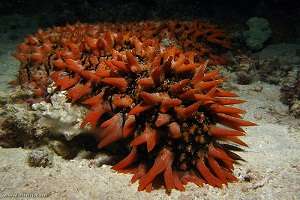Scott Reef's sea cucumber fishery on watch

Research measuring sea cucumber populations in WA's Scott Reef fishery has suggested an improved way of estimating exploitation rates.
The paper demonstrated that estimating exploitation rates – the proportion of population being caught in a certain period – of sea cucumbers using 'removal methods' is more viable than the conventional visual-transect survey.
In collaboration with Australian Fisheries Management Authority (AFMA), Murdoch University and fisheries institutes in Indonesia, the research estimated the population size and exploitation rates for five species of sea cucumbers harvested by Indonesian Fishers.
The researchers trained the fishers to keep detailed sea cucumber catch records during the fishing season over a period of 58 days.
AFMA senior field manager Jim Prescott says exploitation rates are a good indicator of fishery performance and can help researchers understand whether a fishery is well managed.
"Most sea cucumber surveys done around the world use visual census methods, where scientists count the sea cucumber found along transects," Mr Prescott says.
"Such studies produce estimates of sea cucumber density, abundance and biomass but it can be hard for a fishery manager to use these findings unless they can be related to reference values that indicate the health of the stock."
As many species of sea cucumbers are predominantly nocturnal, Mr Prescott says daytime surveys under-estimate their true abundance.
The researchers found many sea cucumber species were far more abundant on the reef than previous studies have estimated.
However, Mr Prescott says recent statistical methods have been developed to estimate abundance using removal or catch data.
"The method we used is a special form of mark-recapture method frequently used to estimate animal abundance," he says.
"Using the software package "MARK", we compared alternative models to test different hypotheses and perform other diagnostic tests."
Mr Prescott says the study demonstrated high exploitation rates of sea cucumbers on the reef top, which would be expected to deplete the stock.
These exploitation rates were supported by another experiment carried out in conjunction, using artificial concrete sea cucumbers that were distributed at three sites.
Mr Prescott says while a high proportion of concrete sea cucumbers were recovered from the reef top, recoveries from places that remained submerged at low tides were much lower.
"This suggested a mechanism for the persistence of the stocks with sea cucumbers in deeper waters the likely source of offspring to maintain the stock."
Although the fishing effort and number of vessels at Scott Reef fishery has declined since 2009, Mr Prescott says sea cucumbers are still intensely fished and fishing effort needs to be reduced.
Provided by Science Network WA















